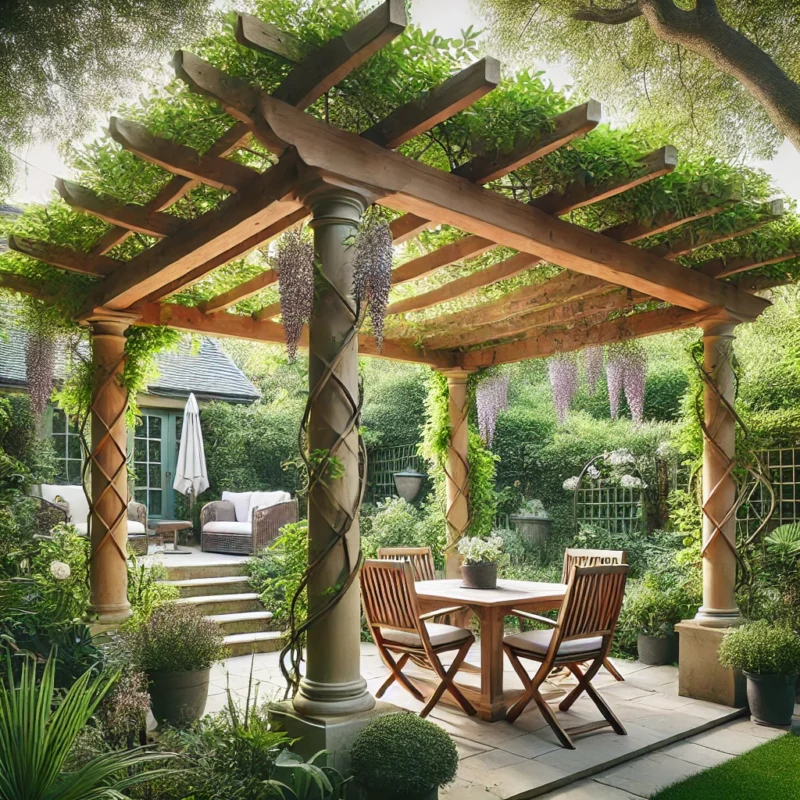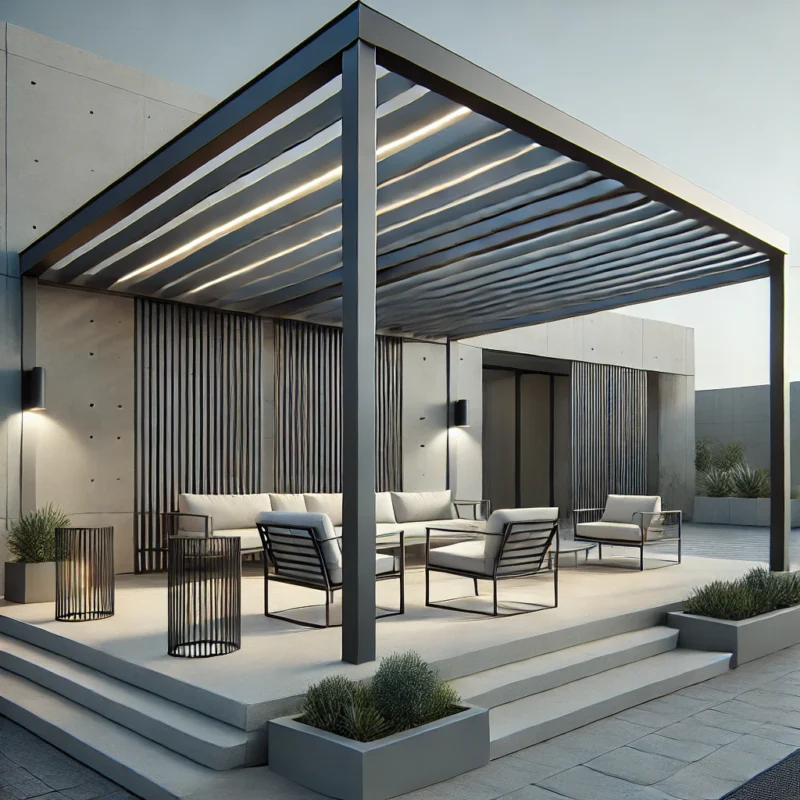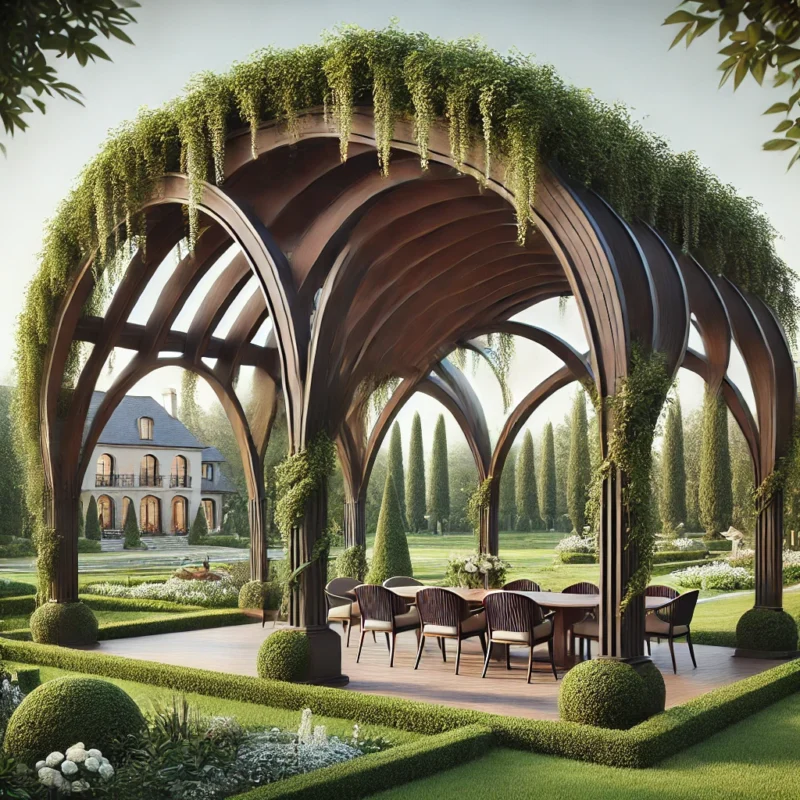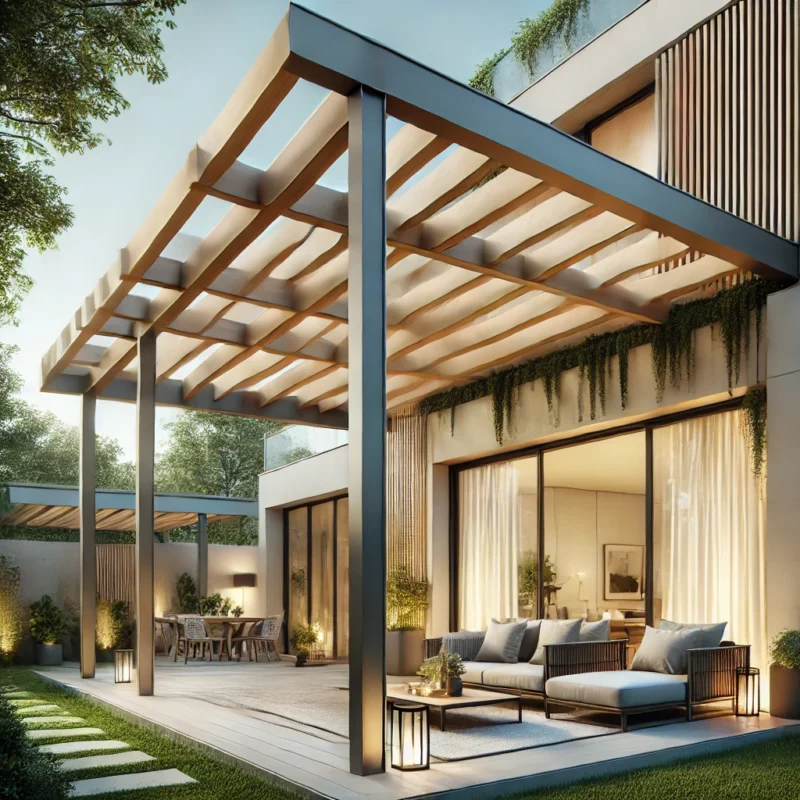A pergola is one of the most versatile and stylish structures you can add to your outdoor space. It provides both function and beauty, creating an inviting and relaxing atmosphere. Whether you’re building a cozy backyard retreat or looking to add architectural interest to your garden, a pergola offers endless possibilities. In this comprehensive guide, we’ll explore what a pergola is, the various types available, its many benefits, and actionable tips on how to make the most of your pergola investment.
Understanding What a Pergola Is?
At its core, a pergola is an outdoor structure consisting of columns that support a roofing grid of beams and rafters. This roofing grid can either be open or covered to provide partial shade or shelter. Unlike gazebos or pavilions, which have solid roofs, pergolas have an open framework that allows for both sunlight and airflow.
- Origin of the Term: The word “pergola” comes from the Latin word pergula, meaning a projecting eave. Historically, pergolas were used in ancient Egypt, Rome, and Greece as garden features that provided shade and a platform for growing vines.
- Key Components:
- Columns or Posts: The vertical supports that hold up the roof structure.
- Beams and Rafters: These form the overhead framework, often left open for climbing plants or outdoor lighting.
A pergola can serve various purposes, from defining outdoor spaces to providing shade and even serving as a focal point for gatherings. It’s a multi-functional addition that enhances the aesthetic appeal and usability of any outdoor area.
Types of Pergolas: Choosing the Right One for Your Space
Pergolas come in different styles and materials, each with its unique charm and functionality. Selecting the right type depends on your space, needs, and design preferences.
1. Traditional Pergola

This classic pergola design features a simple, open-roof framework, supported by four columns. It’s typically made of wood, though modern variations can be found in vinyl or aluminum. Traditional pergolas are popular for their timeless appeal and versatility, easily blending with different architectural styles.
- Best For: Gardens, patios, and backyards that require a touch of elegance without overwhelming the landscape.
- Tip: Enhance a traditional pergola with climbing plants like wisteria or grapevines for a natural canopy effect.
2. Modern Pergola

With clean lines and minimalist design, modern pergolas focus on form as much as function. These structures are often made of metal or composite materials, offering a sleek and contemporary look.
- Best For: Modern homes or urban spaces that require a minimalist outdoor structure.
- Tip: Opt for a retractable canopy to provide flexible shade while maintaining the pergola’s sleek appearance.
3. Arched Pergola

Unlike the flat roof of traditional pergolas, arched pergolas feature a curved roof design, offering a more dramatic visual effect. These are ideal for creating a focal point in larger gardens or public spaces.
- Best For: Large spaces that need a bold architectural statement.
- Tip: Add string lights or lanterns along the arch to create a magical nighttime atmosphere.
4. Attached Pergola

An attached pergola extends directly from the exterior of a home or building, typically over a patio or deck. This style effectively blends indoor and outdoor living spaces, creating a seamless transition.
- Best For: Smaller yards or urban settings where maximizing space is crucial.
- Tip: Use an attached pergola to create an outdoor dining or living area, perfect for entertaining guests.
Materials: Wood, Metal, and More – What to Consider
When it comes to selecting materials for your pergola, durability, aesthetics, and maintenance are key considerations.
Wood Pergolas
Wood is the most traditional and widely used material for pergolas. Common types include cedar, redwood, and pine, all of which are naturally resistant to rot and insects.
- Pros:
- Natural, timeless appeal
- Can be stained or painted to match any aesthetic
- Cons:
- Requires regular maintenance to prevent weathering
- Pro Tip: Choose a high-quality wood like cedar or teak for longevity, and apply a UV-resistant sealant every few years.
Metal Pergolas
Aluminum and steel pergolas offer a sleek, modern look with minimal maintenance. They are often powder-coated for added durability and resistance to rust.
- Pros:
- Low maintenance
- Highly durable
- Cons:
- Can become hot in direct sunlight
- Limited design flexibility compared to wood
- Pro Tip: If choosing a metal pergola, ensure it has a powder-coated finish to resist corrosion and prolong its lifespan.
Vinyl Pergolas
Vinyl pergolas are popular for their affordability and low-maintenance qualities. They often mimic the look of painted wood without requiring upkeep.
- Pros:
- Low maintenance
- Resistant to rot, insects, and UV damage
- Cons:
- Can lack the authentic feel of wood
- Limited color options
- Pro Tip: Vinyl pergolas are perfect for coastal or high-humidity areas where wood may degrade faster.
Benefits of Installing a Pergola
A pergola is more than just an aesthetic addition to your outdoor space. It provides numerous functional and lifestyle benefits, making it a smart investment.
1. Shade and Protection
While pergolas do not provide full shade like gazebos, they can offer partial protection from the sun’s harsh rays. Adding a canopy or retractable roof allows for more control over the amount of sunlight that filters through.
- Actionable Tip: For hot climates, consider installing a UV-blocking canopy to protect against sunburn while still enjoying the outdoors.
2. Enhancing Curb Appeal
A well-designed pergola can significantly increase the visual appeal of your home. It serves as an architectural focal point, drawing attention to beautifully landscaped areas or outdoor living spaces.
- Actionable Tip: Install lighting fixtures or climbing plants to further enhance the pergola’s aesthetic appeal during the evening.
3. Outdoor Living Space
Pergolas create a defined outdoor space, perfect for dining, entertaining, or relaxing. By adding outdoor furniture, lighting, and accessories, you can turn a simple pergola into a fully functional outdoor living room.
- Actionable Tip: Opt for weatherproof furniture and outdoor rugs to make the space feel as cozy and inviting as an indoor room.
4. Increased Property Value
Installing a pergola can add value to your property by making your outdoor space more usable and visually appealing. Buyers often appreciate homes that feature well-designed outdoor structures.
- Actionable Tip: If you’re planning to sell your home in the future, choose a pergola design that complements your home’s architectural style.
How to Maintain Your Pergola for Longevity
Maintaining a pergola, regardless of the material, is key to ensuring its longevity and preserving its beauty.
1. Cleaning and Staining (Wood Pergolas)
Wooden pergolas require regular cleaning and staining to prevent weathering and protect against rot and pests. Clean the pergola at least once a year using mild soap and water, and reapply wood stain or sealant every 2–3 years.
- Actionable Tip: Inspect for signs of termite damage or mold after rainy seasons, and address any issues immediately.
2. Rust Prevention (Metal Pergolas)
If you have a metal pergola, check for rust spots regularly, especially in humid or coastal environments. Minor rust can be sanded down and treated with a rust-inhibiting primer before repainting.
- Actionable Tip: If your pergola is near a pool, be extra cautious of rust, as chlorine can accelerate the corrosion process.
3. Cleaning Vinyl Pergolas
Vinyl pergolas are low-maintenance but can accumulate dirt or mold over time. Use a soft brush and a mixture of water and vinegar to clean the surface.
- Actionable Tip: Avoid harsh chemicals that can strip away the protective coating on the vinyl.
Creative Ideas for Styling Your Pergola
Your pergola can serve as the centerpiece of your outdoor space. Here are a few creative ideas for making your pergola uniquely yours:
- Add Drapes or Curtains: Create a romantic and private retreat by adding outdoor curtains or drapes that can be drawn for shade and privacy.
- Install a Swing or Hammock: Turn your pergola into a relaxation spot by hanging a swing chair or hammock.
- Outdoor Kitchen or Bar Area: If you love entertaining, use your pergola as a cover for an outdoor kitchen or bar area, making it the ultimate social space.
Conclusion
A pergola is more than just a decorative element—it’s a versatile structure that enhances the function and aesthetic appeal of your outdoor space. By understanding the different types, materials, and maintenance needs, you can choose a pergola that suits your lifestyle and elevates your outdoor living experience. Whether you’re using it for shade, as an outdoor dining area, or simply to enhance your garden’s beauty, a pergola is a timeless investment that will add value and charm to your home for years to come.


